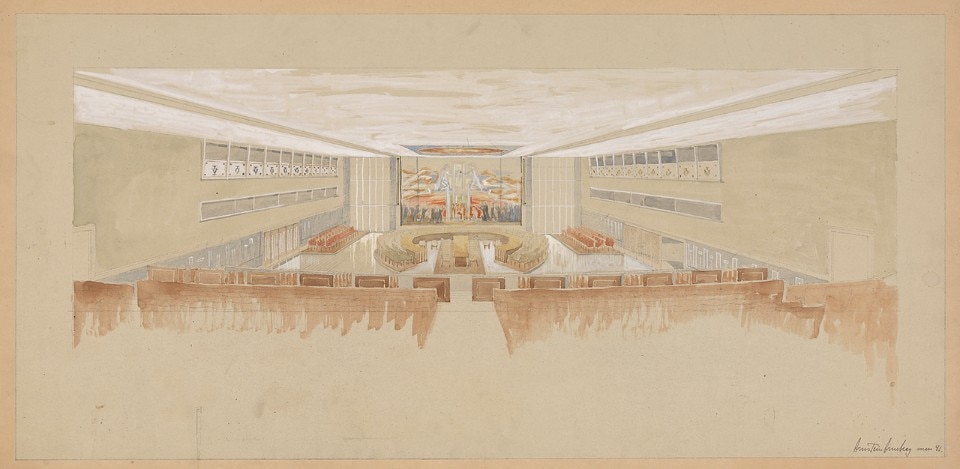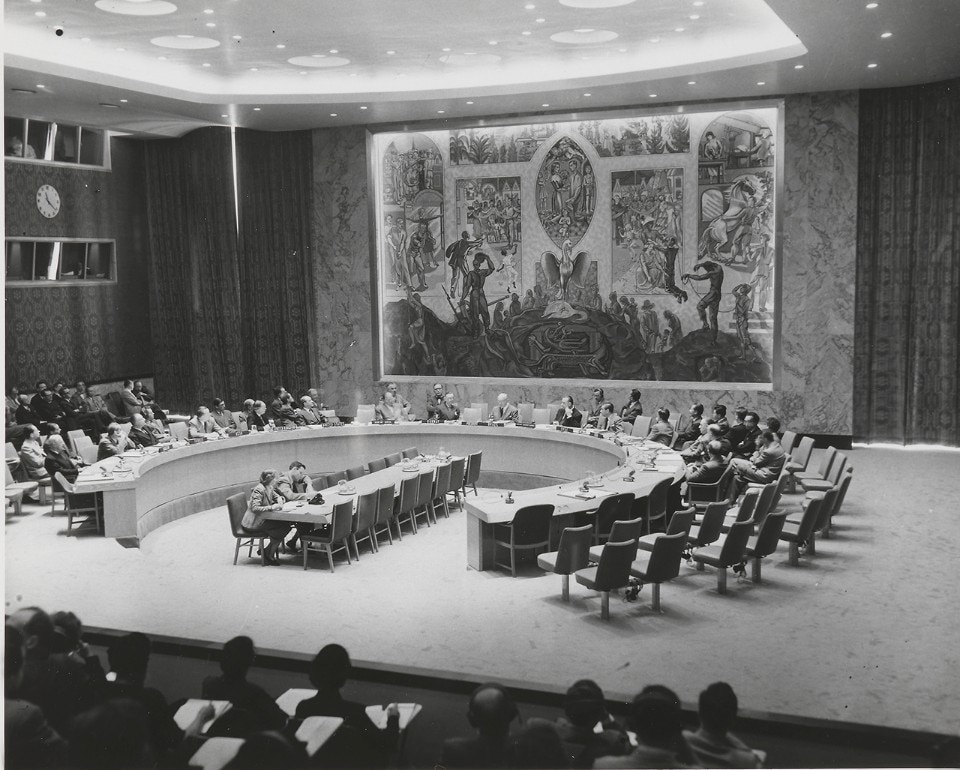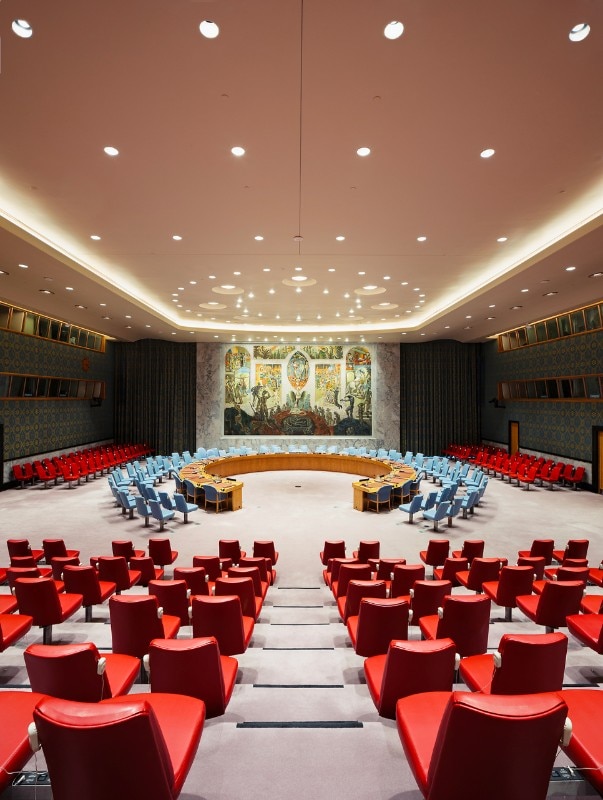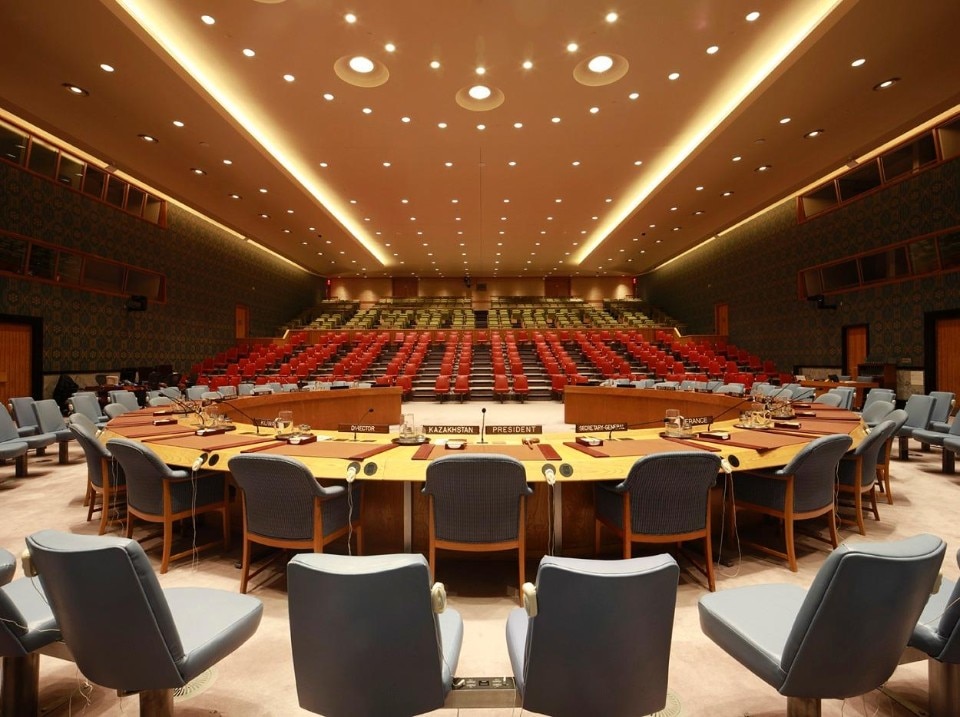When in 2006 it was decided that the United Nations' Security Council chamber in New York City needed renovation, it was obvious that this iconic architectural gem would receive not only a facelift and preservation, but also special care. It would be impossible to stray from the original design. Wherever possible, each detail would be respected in the reconstruction. Any alteration would have disintegrated its 1950s mood, indubitably the embodiment of the mature aesthetics of the Cold War and the fruit of a delicate operation of diplomacy. The chamber having been a gift from Norway, the task of renovation was also assigned to Norway. The UN Secretary General Trygve Lie (1896–1968) was instrumental in encouraging Norway, Sweden and Denmark to contribute funds and architects for their respective assembly rooms within the UN building.

He commissioned Arnstein Arneberg to design and decorate the Security Council chamber while the architect was concluding his work on the impressive Oslo City Hall. What might make us smile today is that Arneberg had recently completed a mountainside chalet for Secretary General Lie. Inaugurated in 1952, the United Nations building was coordinated by the architect Wallace K. Harrison. Arneberg's work on the chamber went unnoticed, for the architectural press was more interested in the heated debates between Oscar Niemeyer and Le Corbusier, who were members of the design team. The creation of the UN's strategic heart was far from being a conversation topic.
Currently on display at National Museum – Architecture in Oslo is a small and very well documented exhibition on the story of the chamber. The book Sikkerhetsrådets sal (Security Council chamber) by Jørn Holme was published to coincide with the exhibition. Both the book and the exhibition are a collaboration with the Norwegian Directorate for Cultural Heritage. When the UN complex opened in Manhattan in August 1952, the interior decoration came across as spartan and conservative and was barely acknowledged. In his homeland, Arnstein Arneberg even had to write his own review of the work, seeing that the national newspapers gave most coverage to the nine-by-five-metre mural painted by his fellow Norwegian Per Krogh (a pupil of Henri Matisse) on the chamber's east wall. They also wrote about what an expensive present the country had given the United Nations.

Acclaim was meagre for the austere and minimal arrangement steeped in a distinct brand of Nordic philosophy. It is easier now to recognise the quality of the design as a precocious example of the overseas exportation of Scandinavian aesthetics. Precisely because the chamber was located at a sensitive point in the modernist enclave of the United Nations, the work by Arneberg and his group did not come into its own until the recent restoration to remove asbestos from the structure. Very few modifications of the original design were made, out of consideration for it being one of the most familiar settings at the UN, and for the planetary fame it enjoys. The enormous C-shaped table and the epically coloured wall painting behind it entered into our collective imagination through television screens everywhere. Cinematographic echoes of the setting are seen in all the "crisis rooms" that followed. Arneberg, who did not supervise the work at the UN constantly, picked a carbon copy of the team he was already collaborating with in Oslo: the famed painter Per Krohg for the mural, and the textile artist Else Poulsson (the granddaughter of the architect Magnus Poulsson) for the damask wallcovering. The doors, chairs, iron balustrades, fabrics and marble were crafted in Norway and shipped to New York, making costs rise considerably. Still, an attempt was made to work frugally. The use of marble for the east wall was reduced, and the structures that could not be built in steel were simply painted.

In 2010, the entire Security Council chamber was stripped of everything. Only the bare concrete walls, the floor slab and the ceiling remained. By the date of inauguration, 16 April 2013, all had been cleaned and reassembled. Decades of nicotine and dust were removed from Krohg's mural and the longitudinal walls. The original blue silk damask with its gold pattern depicting the anchor of faith, the growing wheat of hope and the heart of charity was substituted with a reproduction in rayon. The new print of the textile is painstakingly faithful to the original, and even made by the same Norwegian company. In the 1950s, the silk had been treated chemically to become fireproof, but the results were disappointing and the fabric shrank. The sessions are no longer open to the public since the terrorist attacks on the Twin Towers in 2001, but the room is still accessed by he same awe-inspiring door in ash wood built by Håkon Wollan for an immersion into a timeless space for reflection. In the words of Arneberg, what is known informally as the Norway Room aimed to represent the culture and art of a country whose character was so neutral as to stand the test of time.

Posterity has proven him right. The only thing that has truly aged here is the iconography of the large mural, overly centred on pre-war ideology, populated mostly by Caucasian figures, and anchored in the memory of an anachronistic situation. In a place that should remind us of the dangers of remaining blocked in the past, the image of a phoenix rising from a world in ashes dominates. Arneberg gifted the people succeeding one another at work for the Security Council, seated around his giant table, a space that is still functional, of enduring freshness, and decidedly focused on the future.
- Exhibition title:
- The Security Council Chamber
- Opening dates:
- Until 28 September 2018
- Location:
- National Museum – Architecture
- Address:
- Bankplassen 3, Oslo

